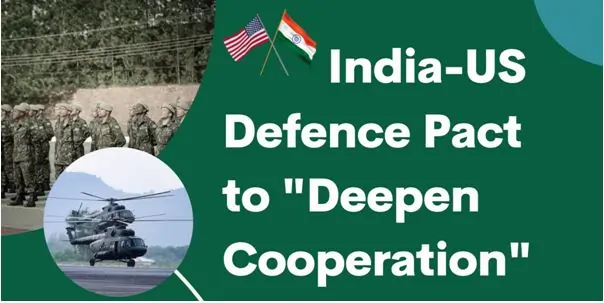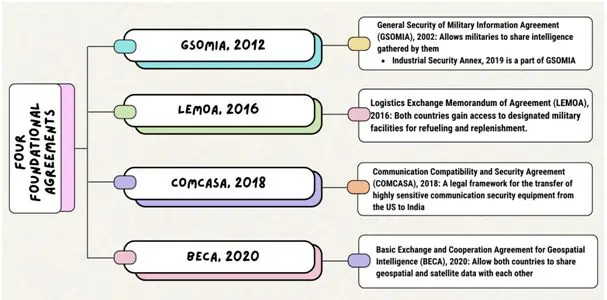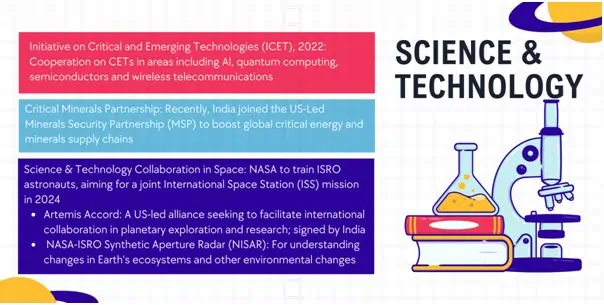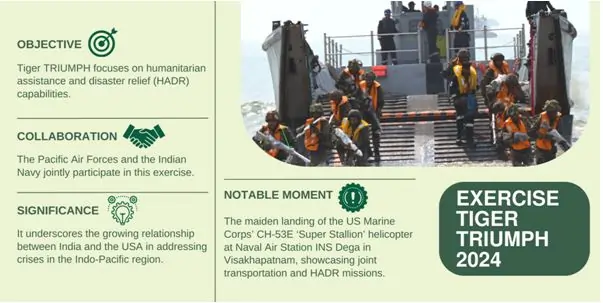
Recently, India and the United States have decided to intensify and expand their already vast “major defence partnership.” This does not only refer to the fields of defence but also includes the space technology and Artificial Intelligence. This is quite interesting to see these two nations developing new technologies that will shape future of security and military.
Key Agreements
The main agreements that have enhanced the India-US defence ties:
- Security of Supplies Arrangement (SOSA):India is 18th in the list to become strategic alliance partner after Japan, Canada and Australia.
- SOSA makes both countries arrange its goods and services for the defence of the nation in case of emergencies.
- It allows the faster supply of goods between the two. SOSA however is not backed by law and it merely operates based on the goodwill hence contributing to the cooperation of the military industries.
Memorandum of Understanding (MoU) on Liaison Officers:
- By the exchange of these Officers listed in MoU seeks to increase interactions.
- The first flashpoint of bilateral military relation is when India appoints an officer in US Special Operations Command in Florida.
- This effort stands in line with previous accords implying a willingness to advance the defence cooperation between the two countries.
Reciprocal Defence Procurement Agreement:
- It is evident that the making of the RDP Agreement is intended to enhance the interoperability,rationalization, inter-changeability and standardization in the defence equipment.
- But when approved it will help US corporations escape particular procurement restrictions to interact with Indian firms as well as support initiatives such as ‘Make in India’.
Looking at the future of India-US defence cooperation, more and more projects, Technologies and research will be key factor to consider. Thus, the emphasis on space, AI, and the collaboration between defence industries make this partnership rather strategic.

How it is Affecting Regional Setting?
Trends in defence cooperation warranted in the India-US treaty have potential in shaping the regional security of the Indo-Pacific region lets deal with it:
Countering Chinese Influence:
- The pact reaffirms India’s position as a part of balancing power in South East Asia of China’s increasing dominance in the region. Through enhancing defence cooperation both the countries expect to restrain China from pressurizing India and other South Asian states.
- This is even more so when China continues to assert its military muscles and grow its military capability and influence projection in the region and the world over; the mutual relationship between India and the US serves as a bulwark.
Operational Cooperation:
- The founding treaties of strategic partnership between India and the USA provide a legal cooperation in operations. It allows joint exercises, sharing of intelligence, sharing of equipment as well as allows compatibility.
- Cooperation can be achieved by sharing information and operation capability during crisis including disaster or security threats which is helpful to regional security situation.
Mitigating Risks:
- The pact to ensure that both the participants minimize on risks attached to the possible conflict. India and the US have neighbours who possess nuclear weapons hence it is easier for tensions to rise such as with Pakistan and China.
- In the respects of threat perception, military co-operation including defence planning, sharing of intelligence information and collaboration in managing a crisis contributes in avoiding an accidental war and encourages balance of power.
Holistic Approach:
- The US and India need to use a diversified view that is not limited to security issues of different levels. Thus, the areas that need to be addressed include the health of the global population, climate change, and technology cooperation.
Technology and Intelligence Sharing:
- The pact promotes high technology partnership and co-development activities. This can result in progress of technology of aspects of defence that is mutually beneficial to both nations.

Cyber, Space, and Nuclear Domains:
- Investing into further consultations in these domains is important. Issues such as cyber security, space security, and nuclear regime are fundamental issues.
- Thus, India and the US can supplement one another capacities and improve their reaction capabilities in these spheres.
How does this pact impact India's relations with other neighbours?
The defence treaty signed between India and US is of far reaching implication for both India and USA but it also has bearings on Indian’s relations with its neighbouring countries. Let’s analyse how this accord might alter regional dynamics:
China:
- The worst is on India which relations with China will significantly be affected. Both the countries India and US are concerned about the china in the region.
- Enhancing defence relationship with US is a clear implication to China that India is not alone and it has friends. It makes china to think twice before doing anything in boarders and in South China Sea.
Pakistan:
- Since a long time Pakistan has been considered as a friendly nation to USA. However, the India-US defence treaty, which is a factor critical for India as a defence partner of US doesn’t directly harm India-Pakistan relation particularly.
- Pakistan may view this with trepidation, however its primary interest lies in regional security issues, particularly internal stability and relation with China.
Nepal and Bhutan:
- All these smaller Himalayan nations have always enjoyed good relations with India. As it has been depicted in the defence deal, the relations between these two do not change fundamentally.
- But they may closely monitor any changes toward an unfavourable dynamics of the bilateral relations of India and China because it may have an adverse impact on their security situation.
Bangladesh:
- It has a good relation with the India and US and not had a bad agreement with china but still some issues with china are still to fixed in context of Bangladesh-China relations.
- Here, the defence treaty does not directly interact with Bangladesh but any tensions that could be caused by the building up of tensions between the involved countries could compromise on the two aspects of interest to Bangladesh: commerce and security.
Sri Lanka:
- Sri Lanka sees China as an important relationship and also has a relationship with India just the same. It provides the accommodation of Chinese investment and infrastructure.
- The defence treaty could make Sri Lanka to cautiously engage itself in relations with both India and the US, so as not to be caught in any entangled power politics.
ASEAN Countries:
- ASEAN countries are the significant players in the Indo-Pacific region which is a group of Southeast Asian nations.
- The defence agreement between India and the US is in consonance with ASEAN’s vision of a free and open architecture of the Indo-Pacific region.
Historical time line of India US defence relations.
1947 - Independence and Neutrality:
- August 15, 1947: India gets freedom from the British rule. The division of the Indian subcontinent is brought about by the Indian Independence Act resulting to the creation of Pakistan headed by Jinnah as well as the secular Nation of India.
- 1949 – Prime Minister of India Jawaharlal Nehru visit to USA thus define the relation and setting the tone of India’s policy of proclaimed neutrality during the emerging cold war. Such policy was followed during India’s inclusion to the Non-Alignment Movement.
1950s - Martin Luther King Jr. and Gandhian Nonviolence:
- February 24, 1959: The beginning of civil rights movement of America, Martin Luther King Junior’s tours India for a month. With the nonviolent civil disobedience of Gandhiji, King restates the use of nonviolence when he comes back to the United States.
- His words echo the power of nonviolence: “the most powerful toolbox that can be used by the oppressed persons so that they can fight for their rights and human value.”
1959 - President Eisenhower’s Visit:
- December, 1959:US president Dwight D. Eisenhower makes a journey to India and he becomes the first serving President of the U.S.A. to visit it. He also meets the Indian President Rajendra Prasad as well as the Prime Minister of India.
- This visit can be considered a significant stage on the way developing bilateral friendly relations.
1960s - U. S. Universities Support Indian Technological Institute:
- In 1960s, nine American universities come together to join with the U. S. Agency for International Development (USAID) to start one of the first of Indian Institutes of Technology (IITs).
- A number of American faculty members are involved in the academic programs and research laboratories of the new university, and therefore, higher education cooperation between the two nations.
1990s - Post-Cold War Era and Economic Reforms:
- Cold war had been coming to an end and this lead to the exploration of other possible ways of friendly cooperation. India pursues economic liberalisation, and defences relations gradually increased.
- The opening up of economy from 1991 makes more promotion possible
2000s - Strategic Partnership and Defence Cooperation:
- The early part of the 2000s experience a shift of some sort. Strategic relations between India and the U. S are in progress.
- May 2005: Considering India as a privileged strategic partner, the United Sates and India sign The U.S.-India Peaceful Nuclear Cooperation (123 Agreement).
- Defence cooperation deepens through continuing joint manoeuvres and joint technology acquisition, as well as annual joint dialogues.
2014 Onward - Deepening Strategic Cooperation:
- 2014 – The strategic cooperation between the two increases to the next level. India has become the major defence strategic partner to the counterpart.
- Quad is a modern organisation has been proved effective in the indo-pacific region to counter china. It has Japan, US and Australia with India as members.
- Today both thenations’ conducts defences research, development and trade in joint settings.
Present and Beyond:
- India and the U. S. have increased their cooperation in various sectors since 2014 such as defences technology and multilateralism.
- It has been the long-standing cooperation between both nations which indicates the common factors of interests and concern towards the regional security.
Major joint exercises between the two nations:
Large scale exercises between India and US are major and include things like warfare, military cooperation etc.The two countries have the potential to be strategic partners and undertake several joint military exercises for boosting up their capabilities. Here’s a list of some notable exercises conducted between the Indian armed forces and the U. S. military:
VajraPrahar:
- Participants: India and USA
- Purpose:VajraPrahar deals with specially the training of Special Forces, Counter Terrorism Operations, joint exercise with the Indian Army and later with U.S Army.
- Frequency: Regularly held.
YudhAbhyas:
- Participants: India and USA
- Objective:YudhAbhyas is designed to enhance the level of joint combat and further refine tactical designs and synchronization between both the infantry force of Indian and US.
- Frequency: Regularly held.
Tiger Triumph:
- Participants: India and USA
- Focus: Tiger Triumph focuses is on humanitarian aid, disaster relief, and amphibious activities.
- Duration: It is a progressive procedure that may take any number of weeks.

Red Flag (primarily an air exercise):
- Participants: Indian Air Force (IAF) and United State of America Air Force (USAF)
- Purpose: Red Flag entails actual warfare simulation, aerial combat training, as well as compatibility of different aircraft systems.
- Location: It was conducted in Nellie Air Force base in Nevada, USA.